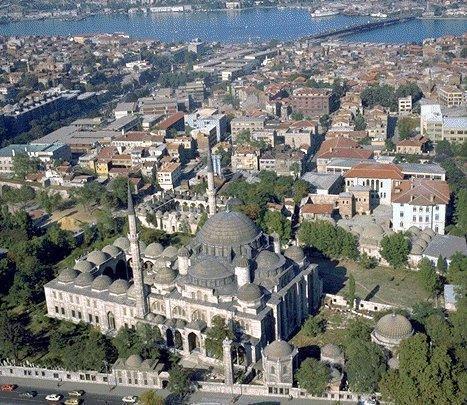The Book Club discussion

This topic is about
Istanbul Passage
March - April, 2013
>
Chapter 1: Bebek (3 - 63)
date newest »
newest »
 newest »
newest »
message 1:
by
Lily
(new)
-
rated it 4 stars
Mar 27, 2013 08:18PM
 Use this thread for comments and links for Chapter 1: Bebek (~60 pp).
Use this thread for comments and links for Chapter 1: Bebek (~60 pp).
reply
|
flag
 Finally downloaded
Istanbul Passage
last night, I am about half way through the book tonight -- I'm finding it definitely a page turner that has captured my attention.
Finally downloaded
Istanbul Passage
last night, I am about half way through the book tonight -- I'm finding it definitely a page turner that has captured my attention.The first chapter sets up the action and immediately creates a sense of suspense along several parameters, from Tommy King's fate to Anna's disabilities to Alexei's future to the involvement and roles of Leon and Mihai.
 Bebek: a historic Istanbul neighborhood located on the European shores of the Bosphorus. This affluent neighborhoods is surrounded by similar ones such as Arnavutköy, Etiler and Rumeli Hisarı.
Bebek: a historic Istanbul neighborhood located on the European shores of the Bosphorus. This affluent neighborhoods is surrounded by similar ones such as Arnavutköy, Etiler and Rumeli Hisarı."The direct translation of the word 'Bebek' from Turkish is 'baby', which is a reference to the neighborhood's attractive positioning on the Bosphorus with its deep, sheltered bay and sweeping views in both directions along the waterway. It is believed to be a shortened form of 'Boğaz'ın Gözbebeği', which translates, literally, as 'the pupil of the Bosphorus', or more appropriately, 'the apple of Bosphorus' eye', as the literal translation of 'pupil' in Turkish is 'eye baby'."
http://en.wikipedia.org/wiki/Bebek,_I...
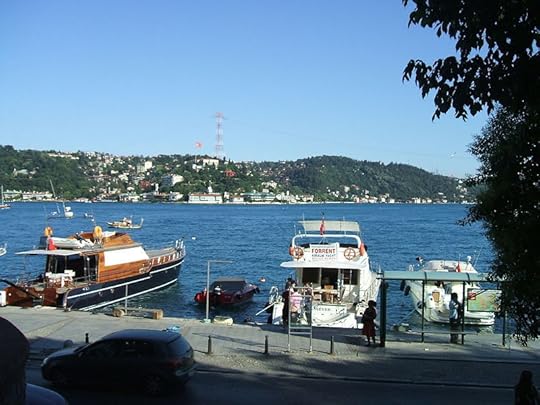
 Probably not particularly like the cafe where Leon goes to make a call. I imagined something much more dark, watering-hole-like. Still, some perspective of the probable area:
Probably not particularly like the cafe where Leon goes to make a call. I imagined something much more dark, watering-hole-like. Still, some perspective of the probable area:https://foursquare.com/v/lokma-cafe/4... -- a cafe -- lots of pictures of food, people, cars, views, ...
"Then you run back. Again, wet. To a waiting car. That will be less suspicious. If anyone is watching.” He put the car in gear.
“It’s your car,” Leon said. “That’s all.”
“You think they haven’t seen it by now?”
“Have they? You’d know,” he said, a question.
“Always assume yes.”
He made a turn across the road, pulling up in front of the café.
“So do the expected thing. Stay dry. Tell me something. If he had come, your package, was I going to drive him to— wherever he’s staying?”
“No.”
Mihai nodded. “Better.” He motioned his head to the side window. “Make the call. Before they wonder.” There were four men playing dominoes and sipping tea from tulip glasses. When they looked up, Leon became what he wanted them to see— a ferengi caught in the rain, shaking water from his hat, needing a phone— and he flushed, a little pulse of excitement...
Kanon, Joseph (2012-05-29). Istanbul Passage. (pp. 5-6). Simon & Schuster, Inc. Kindle Edition.
 Rueli Hisari
Rueli Hisari"Just before the Fatih Bridge are the majestic structures of Rumeli Hisarı and Anadolu Hisarı (Fortress of Anatolia). Mehmet the Conqueror had Rumeli Hisarı built in a mere four months in 1452, in preparation for his siege of Byzantine Constantinople. For its location, he chose the narrowest point of the Bosphorus, opposite Anadolu Hisarı, which Sultan Beyazıt I had built in 1391. By doing so, Mehmet was able to control all traffic on the strait, cutting the city off from resupply by sea."
http://www.lonelyplanet.com/turkey/is...
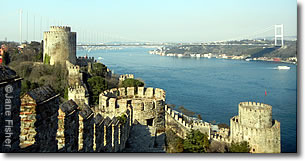
View of the Bosphorus and Fatih Bridge from Rumeli Hisari.
http://www.turkeytravelplanner.com/go...

Rumeli Hisari viewed from the Bosphorus
 "...Dr. Obstbaum had been one of the German refugees welcomed by Atatürk in the thirties to help the new republic get up on its feet...."
"...Dr. Obstbaum had been one of the German refugees welcomed by Atatürk in the thirties to help the new republic get up on its feet...."Ibid. (p. 9).
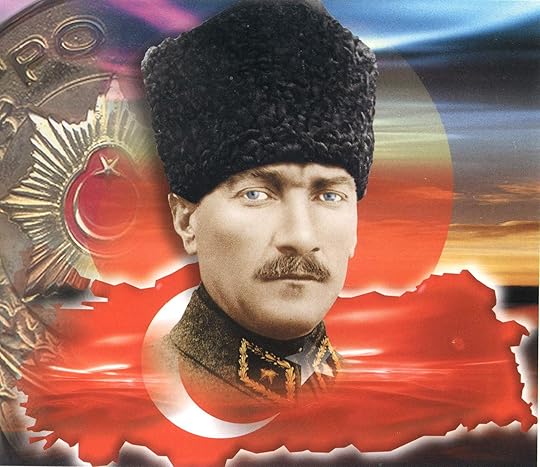
"Mustafa Kemal Atatürk was an Ottoman and Turkish army officer, revolutionary statesman, writer, and the first President of Turkey. He is credited with being the founder of the Republic of Turkey." Google profile.
http://en.wikipedia.org/wiki/Atat%C3%...
http://en.wikipedia.org/wiki/Atat%C3%...
Note the blue eyes. I think that was true.
 133 pictures of Ortakoy. Note 77 and 104 -- not so much because of relationship to our story, just different views from many of the others here. (May change, site probably shifts.)
133 pictures of Ortakoy. Note 77 and 104 -- not so much because of relationship to our story, just different views from many of the others here. (May change, site probably shifts.)http://www.tripadvisor.com/Attraction...
The ones who could afford it had moved to Bebek or, closer in, Ortaköy, where hillsides covered in fir trees and lindens may have reminded them of home. Or maybe, lemminglike, they had simply followed the first settler. Most of the clinic’s medical staff was still German, which Leon had thought might help, her own language something she would understand, if she was still listening.
Ibid. (p. 9).
 "....Obstbaum thought it had happened then, when the Bratianu sank. Corpses bobbing in the water. Children. Her brain turning away from it, drawing a curtain. Obstbaum had even suggested she be put in a garden room, not a front one facing the Bosphorus, where ships passed all day, each one a possible reminder. Leon had gone along with him. Everyone in Istanbul wanted to see the water— in Ottoman times there had been laws about builders blocking the view— so a garden room was cheaper. And it was pleasant, looking toward the hillside, cypresses and umbrella pines and a Judas tree that dropped pink blossoms in the spring. A fortune back home but something he could manage here. And not a boat in sight."
"....Obstbaum thought it had happened then, when the Bratianu sank. Corpses bobbing in the water. Children. Her brain turning away from it, drawing a curtain. Obstbaum had even suggested she be put in a garden room, not a front one facing the Bosphorus, where ships passed all day, each one a possible reminder. Leon had gone along with him. Everyone in Istanbul wanted to see the water— in Ottoman times there had been laws about builders blocking the view— so a garden room was cheaper. And it was pleasant, looking toward the hillside, cypresses and umbrella pines and a Judas tree that dropped pink blossoms in the spring. A fortune back home but something he could manage here. And not a boat in sight." Ibid. (p. 11).
When I search the name of the ship, I get information about a Romanian family and leader. I believe I have already posted the link to an article about these boats and a historic disaster, but don't remember where right now.
 "Famous as the terminating point for the Orient Express, Sirkeci remains one of the main travel hubs for Istanbul, connecting suburban train, tram and ferry systems. The Sirkeci Station of the Turkish State Railways is the terminating node of the European railway network leading into Istanbul, the two main lines from Thessaloniki, Greece and Bucharest, Romania...."
"Famous as the terminating point for the Orient Express, Sirkeci remains one of the main travel hubs for Istanbul, connecting suburban train, tram and ferry systems. The Sirkeci Station of the Turkish State Railways is the terminating node of the European railway network leading into Istanbul, the two main lines from Thessaloniki, Greece and Bucharest, Romania...."
Sirkeci Station
"Sirkeci is an area in the Eminönü neighborhood of the Fatih district of the city of Istanbul, Turkey."
http://en.wikipedia.org/wiki/Sirkeci
"...The work had been open— arranging visas for the weekly train to Baghdad, the overland route to Palestine. Just a trickle of refugees, but legal. The police watched Anna go to the Red Crescent offices, watched her check the manifest lists at Sirkeci, watched the transfer to Haydarpaşa, a pattern so familiar they never thought to look anywhere else. When the illegal work began, Mihai’s boats, they were still following Anna to Sirkeci, still smoking in the lobby...."
Ibid. (p. 13).
I believe there is a picture later of the modern terminal. The change is striking.

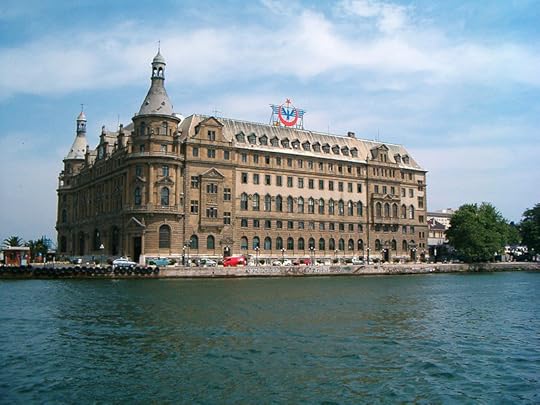
Haydarpaşa in 2007
The Haydarpaşa Terminal is a major intercity terminal and transportation hub in Kadıköy, İstanbul, on the Asian side of the Bosphorus.
http://en.wikipedia.org/wiki/Haydarpa...
The wiki article describes the major fire there in 2010 and the efforts to save the site as a historic heritage location.
I think Sirkeci-Haydarpaşa would represent the overland movement of refugees Anna was aiding on their journey to Israel/Palestine -- not sure of the status of the territories at the time.
 Yıldız Park is a historical, urban park in Beşiktaş district of Istanbul. Yıldız Park was once part of the imperial garden of Yıldız Palace. Extending down the slopes from the palace, this walled park was reserved only for palace dwellers during the reign of Sultan Abdulhamid II. The area of Yıldız used to be a forest in Byzantine times. Starting during the reign of Suleiman the Magnificent, the sultans made it their hunting grounds. In the next centuries, it remained as a grove behind the seaside palaces.
Yıldız Park is a historical, urban park in Beşiktaş district of Istanbul. Yıldız Park was once part of the imperial garden of Yıldız Palace. Extending down the slopes from the palace, this walled park was reserved only for palace dwellers during the reign of Sultan Abdulhamid II. The area of Yıldız used to be a forest in Byzantine times. Starting during the reign of Suleiman the Magnificent, the sultans made it their hunting grounds. In the next centuries, it remained as a grove behind the seaside palaces. From wiki article: http://en.wikipedia.org/wiki/Y%C4%B1l...
A ~2min video of the park:
http://www.youtube.com/watch?v=tIBqb8...
[image error]
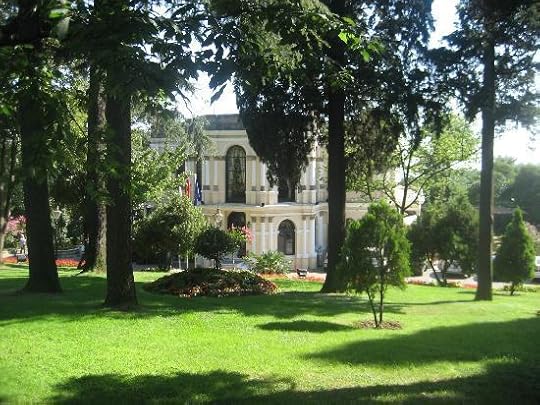
This photo of Yildiz Park is courtesy of TripAdvisor"
More description: http://www.lonelyplanet.com/turkey/is...
...Someone was dead, had to be. And he hadn’t felt anything, just the blind panic of firing back, saving himself. It must be different for snipers, taking aim, knowing you’re about to kill. Detached, not shaking later, gripping the wheel tighter, head filled with it.
“It was supposed to be a simple pickup,” he said.
They drove for a while in silence, then skirted the dark border of Yildiz Park where Sultan Abdul Hamid had walled himself away, frightened of shadows. Leon glanced at the rearview mirror. Nobody behind...
Ibid. (pp. 45-46).
 There are many good pictures of the şehzade Mosque in this Flickr stream, including overall architecture, the adjacent mausoleum yard, and details of Islamic art and calligraphy on tiles and in cornices:
There are many good pictures of the şehzade Mosque in this Flickr stream, including overall architecture, the adjacent mausoleum yard, and details of Islamic art and calligraphy on tiles and in cornices:http://www.flickr.com/photos/brokendr...
"...Small, quiet streets, then a larger one looking down toward the şehzade Mosque. A modern building with a buzzer entry system, not a courtyard with a nosy kapici. Leon opened the front door with a key. More timer switches on the stairs, but at least everything working, the lobby clean, smelling faintly of disinfectant...."
Ibid. (p. 51).
In the area where Alexei was to stay.
kapici -- doorman, caretaker, porter.
 "Sinan’s first truly important architectural commission was the Şehzade Mosque, which was completed in 1548 and which Sinan regarded as the best work of his apprenticeship. Like many of his mosque constructions, the Şehzade Mosque has a square base upon which rests a large central dome flanked by four half domes and numerous smaller, subsidiary domes."
"Sinan’s first truly important architectural commission was the Şehzade Mosque, which was completed in 1548 and which Sinan regarded as the best work of his apprenticeship. Like many of his mosque constructions, the Şehzade Mosque has a square base upon which rests a large central dome flanked by four half domes and numerous smaller, subsidiary domes." "...mosques that still dominate the Istanbul skyline:
1) the Fatih külliye (1463–70),
2) the Bayezid Mosque (after 1491),
3) the Selim Mosque (1522),
4) the Şehzade külliye (1548), and
5) the Süleyman külliye (after 1550)."
http://www.britannica.com/EBchecked/t...
" Külliye , deriving from the Arabic word 'kull' (meaning the whole, all) ... designates a complex of buildings, centered around a mosque and managed within a single institution, often based on a vakıf (foundation), and composed of a medrese, a darüşşifa, kitchens, bakery, hammam, other buildings for various benevolent services for the community and further annexed constructions."
http://en.wikipedia.org/wiki/K%C3%BCl... -- entry lists three above in Istanbul as well as notable others throughout the Muslim world.
As has been true throughout history and the world, a considerable part of the power of churches/religion has derived from feeding the impoverished.

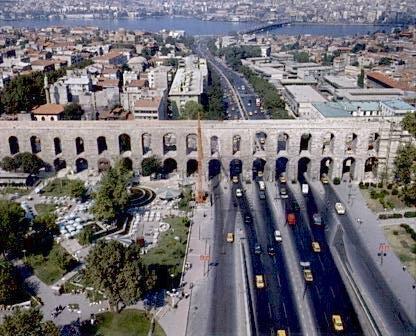
Valens Aqueduct.
More here: http://guidesofistanbul.com/eng/valen...
"...He walked over to the window. 'Where are we? What part?'
“'The old city.'
“'Constantinople,' Alexei said, playing with it for effect, a student reciting homework. 'And that?' He pointed to a hulking shadow beyond the mosque.'
"'Valens Aqueduct.'
“'Aqueduct? From Romans?'
“'Byzantine. Fourth century.' A fact he’d picked up from Anna on one of their walks."
Ibid. (p. 52).


Ion Antonescu
"After forcing King Carol II into exile, he appointed himself "Conducãtor" and soon allied himself with the Axis. In this role he retook lost portions of Romania and the city of Odessa (which he tried to rename to 'Antonescu'), and participated in the invasion of Russia. When this invasion proved a disaster, Carol II's son, Mihail deposed Antonescu and handed him over to Soviet authorities. The postwar Communist government of Romania found him guilty of war crimes in 1946 and executed him. His rule saw the killing or deportation of over 300,000 Jews, mostly from newly occupied areas. To maintain Romania's economy, he permitted most of the Jews in "Old Romania" to live, and refused requests from Hitler to deport them. Antonescu provided more support to the Nazi war machine than all other Axis powers put together."
http://www.nndb.com/people/345/000117...
http://en.wikipedia.org/wiki/Ion_Anto... -- too long to want to read it. Another picture.
Mihai and Leon discuss who Alexei might be, then learn of the death of Tommy from Ed Burke. Yes, they recognize what has happened. But, why?
(view spoiler)
Kanon, Joseph (2012-05-29). Istanbul Passage. (pp. 58-59). Simon & Schuster, Inc.. Kindle Edition. (view spoiler)
 "Outside, Leon crossed the street heading toward Süleyman’s Mosque, then ducked suddenly into a doorway catty-corner from the building. A few minutes, just to be sure. No one in the streets. He felt the same tingling, the caffeine alertness he’d felt on the quay. He should have arranged for someone to watch the building. But there hadn’t been any reason for that. Not a few hours ago. A simple pickup, just slipping someone in and out of the country, a kind of card trick. Not shoot-outs, someone lying in a pool of blood. Or carried away by now, tossed into the Bosphorus, another secret in the water."
"Outside, Leon crossed the street heading toward Süleyman’s Mosque, then ducked suddenly into a doorway catty-corner from the building. A few minutes, just to be sure. No one in the streets. He felt the same tingling, the caffeine alertness he’d felt on the quay. He should have arranged for someone to watch the building. But there hadn’t been any reason for that. Not a few hours ago. A simple pickup, just slipping someone in and out of the country, a kind of card trick. Not shoot-outs, someone lying in a pool of blood. Or carried away by now, tossed into the Bosphorus, another secret in the water."Ibid. (pp. 53-54). -- precedes clip with last post.
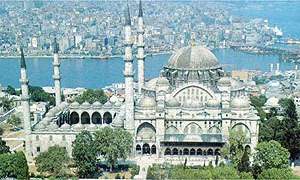
Suleyman Mosque
Always the orientation towards the water. One begins to imagine one could get the lay of the city from the pictures and maps alone, if one tried hard enough. (Not a feeling I have ever had about, say, London or Rome. It's like the Bosporus and the bridges and the Mosques provide orientation and landmarks.)
 I'll plan to get more on the Suleyman Mosque in association with another chapter. I am probably going to run out of time this week, but it is fun to revisit the book. It is almost as if Kanon takes his reader on a tourist's (mystery) tour of Istanbul. A virtual tour is rather what I'm trying to make these posts.
I'll plan to get more on the Suleyman Mosque in association with another chapter. I am probably going to run out of time this week, but it is fun to revisit the book. It is almost as if Kanon takes his reader on a tourist's (mystery) tour of Istanbul. A virtual tour is rather what I'm trying to make these posts.
 Somehow, I have neither the heart nor the stomach to visit the Romanian or Russian sites that Mihai speaks about:
Somehow, I have neither the heart nor the stomach to visit the Romanian or Russian sites that Mihai speaks about:"'...You know Bucharest?'
"'No.'
"'Dudeşti was the main Jewish district. Three days they went crazy there. First Strada Lipscani, a killing spree, looting. Then out in the Băneasa forest, making them dig pits before they shot them. The reason for this, by the way? No one said. Enough they were Jews. But the second day, before Antonescu decided to send the tanks, the Guard went even crazier. Maybe they drank each other’s blood again, who knows. For courage. What courage? Who was fighting them? Terrified Jews, begging for their lives? That was the day they got two hundred of them— men, women— and took them to Străuleşti.' He stopped, then tossed back the rest of the drink. 'The slaughterhouse. South of town. An abattoir.'"
Kanon, Joseph (2012-05-29). Istanbul Passage. (pp. 59-60). Simon & Schuster, Inc.. Kindle Edition.
(Yes, I am not entirely consistent in the ways I have done citations....)
 In the months after I lost J. and was trying to figure out what grief was all about for humankind, I read a very dark, almost black, but moving account, this set in Poland as I recall (okay, Russia):
In the months after I lost J. and was trying to figure out what grief was all about for humankind, I read a very dark, almost black, but moving account, this set in Poland as I recall (okay, Russia): Night of Stone: Death and Memory in Twentieth-Century Russia by Catherine Merridale
Night of Stone: Death and Memory in Twentieth-Century Russia by Catherine Merridale
Books mentioned in this topic
Night of Stone: Death and Memory in Twentieth-Century Russia (other topics)Istanbul Passage (other topics)

